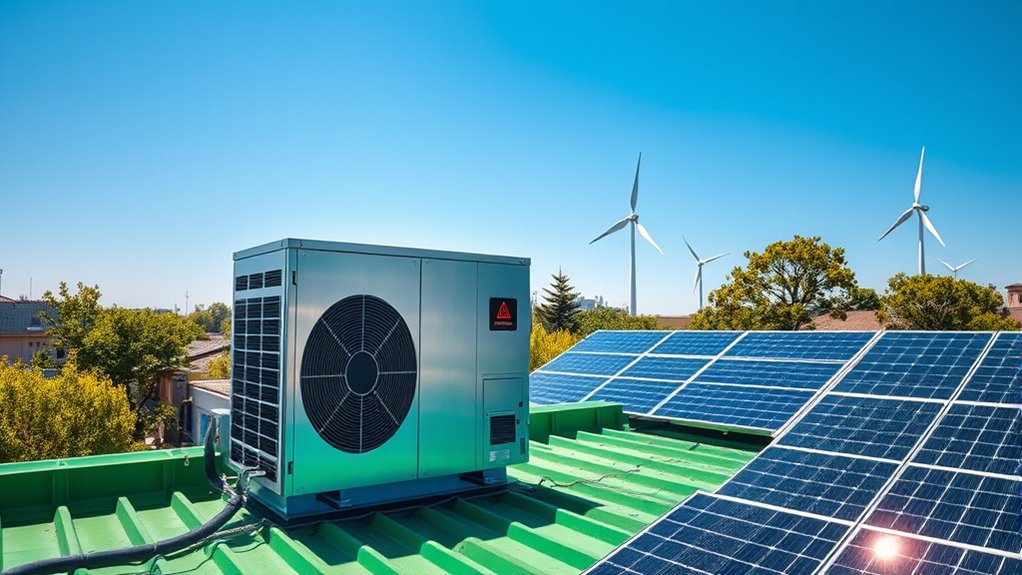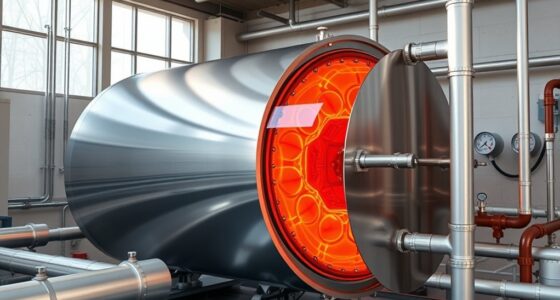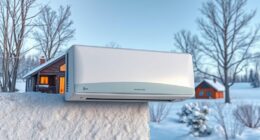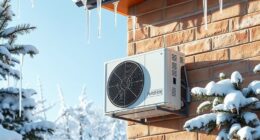Heat pumps are essential for moving toward 100% renewable energy by efficiently harnessing ambient heat from air, water, or ground sources. They reduce reliance on fossil fuels, cut emissions, and work well across various climates and applications, especially with technological advances. Supporting policies and innovations are accelerating their adoption worldwide. To learn how heat pumps are shaping a sustainable future and overcoming current challenges, continue exploring the key developments and strategies involved.
Key Takeaways
- Heat pumps enable efficient use of renewable electricity, supporting the shift to 100% renewable energy for heating needs.
- Integrating heat pumps with solar and wind power reduces reliance on fossil fuels in heating systems.
- Deployment of heat pumps accelerates decarbonization across residential, commercial, and industrial sectors.
- Policy incentives and technological innovations are vital for scaling heat pump adoption in renewable energy transitions.
- Heat pumps contribute to achieving net-zero targets by replacing fossil fuel-based heating with clean, renewable solutions.
Understanding Heat Pumps and Their Functionality
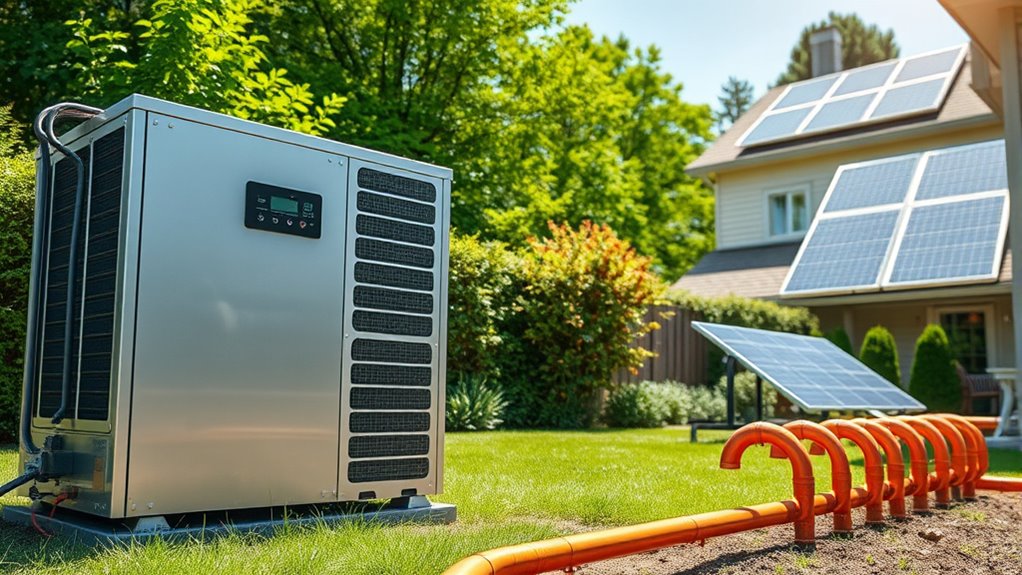
Heat pumps work by transferring heat from a source such as air, water, or ground to a desired indoor space, effectively functioning in reverse like a refrigerator or air conditioner. They use pump technology to absorb thermal energy from renewable energy sources, making them highly energy efficient. Instead of generating heat directly, heat pumps move existing thermal energy, which reduces energy consumption and lowers carbon emissions. The heat source—whether air, water, or ground—determines the system’s efficiency and suitability for different climates. Modern heat pumps can operate effectively even in cold temperatures, delivering high-temperature heat for various applications. Additionally, advancements in smart system technology further enhance their efficiency and user control. By harnessing renewable energy sources, heat pumps offer a sustainable and versatile solution for heating and cooling, supporting the *shift* to cleaner, more efficient energy use. Incorporating vertical storage solutions can optimize space and improve system performance in residential settings. Understanding heat transfer principles is essential for designing efficient heat pump systems that maximize energy savings and performance. Moreover, ongoing innovations in refrigerant technology contribute to reducing the environmental impact of heat pump systems.
The Role of Heat Pumps in Global Energy Decarbonization
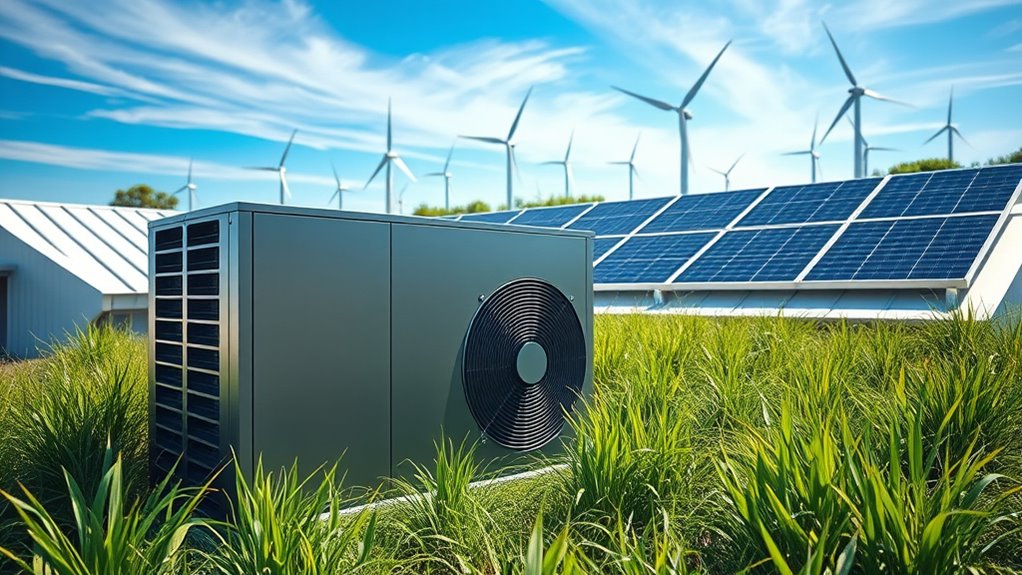
Heat pumps are key to reducing global carbon emissions from heating, especially as policies and markets increasingly favor clean energy solutions. Their higher efficiency and ability to integrate with renewable electricity make them essential for achieving net-zero goals. To maximize their impact, widespread adoption and supportive policies must drive market growth toward nearly tripling sales by 2030. Additionally, understanding the Gold IRA options available can provide financial security for those investing in sustainable technologies. Incorporating renewable energy integration strategies enhances the effectiveness of heat pumps and accelerates the transition to a low-carbon economy. Leveraging energy efficiency advancements can further optimize their performance and contribute to more sustainable energy consumption. Emphasizing solar and wind power integration with heat pump systems can significantly increase their effectiveness and reliability. Developing regulatory frameworks that support renewable energy projects is also crucial for scaling up deployment and ensuring long-term success.
Efficient Heating Solutions
As the world seeks to cut carbon emissions, heat pumps emerge as a key solution for transforming heating systems globally. They offer highly efficient heating by transferring more heat energy than the electrical energy they consume, with efficiencies of 300-400%. This makes them a essential part of decarbonization efforts. Heat pumps can harness renewable energy from sources like air, water, and ground heat, providing sustainable heating options worldwide. Advances in technology, including cold climate and high-temperature models, are expanding their use across diverse sectors. The table below highlights key benefits of heat pumps:
| Benefit | Efficiency | Renewable Integration | Climate Suitability | |
|---|---|---|---|---|
| Reduce emissions | 300-400% heat transfer | Leverage renewable energy | Work in cold climates | Additionally, ongoing technological innovations continue to improve their performance and adaptability in various environments. |
Policy and Market Drivers
Policy and market drivers play a crucial role in accelerating the adoption of heat pumps worldwide, making them a central component of global decarbonization efforts. Policy support through subsidies, tax credits, and carbon pricing incentivizes the switch to pump solutions, fostering market growth and expansion. Countries like the EU, China, and Japan are leading with policies that classify renewable heat as renewable when powered by renewable electricity, boosting energy transition efforts. Despite a 3% global sales decline in 2023, China’s 12% growth highlights the importance of supportive policies for market expansion. Achieving net-zero targets requires nearly tripling the global heat pump stock by 2030, which depends on policy incentives, infrastructure investments, and cost reductions to overcome market barriers. Additionally, the development of heat pump technology enhances efficiency and reduces costs, further supporting market growth. Supporting market policies such as standards and regulations can further accelerate adoption and innovation in this sector.
Current Trends and Market Developments in Heat Pump Deployment
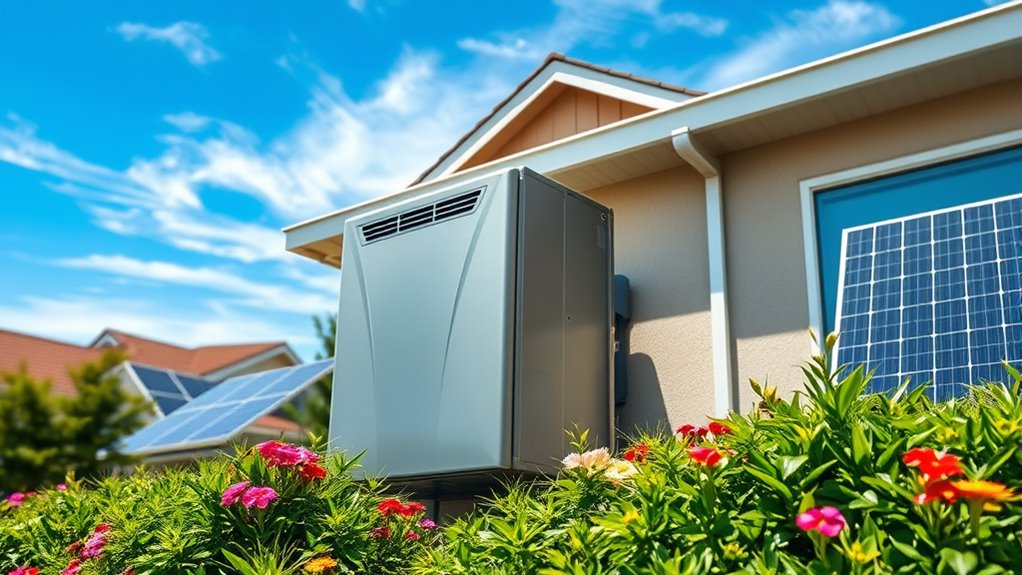
Despite a slowdown in 2023, global heat pump sales remain a key focus for renewable energy expansion, with China leading the way in production and exports. Market developments show that while overall sales declined by about 3%, China experienced a 12% increase, bolstering its position as the largest producer, accounting for around 35% of global heat pump output. The heat pump stock is set to nearly triple by 2030 to meet Net Zero targets, demanding expanded manufacturing capacity. Advances in heat pump technology are improving efficiency, but market barriers like installer shortages and limited deployment projects hamper growth, especially in Europe and the US. These trends highlight ongoing efforts to reduce energy consumption and increase reliance on renewable sources within the evolving heat pump market. Green juice innovations in heat pump components are also contributing to higher performance standards, further supporting the transition to renewable energy. Additionally, integrating lifestyle strategies such as remote work can enhance energy efficiency at the consumer level, and promoting training programs for installers can help address the current skills gap and accelerate deployment. Moreover, the development of noise reduction technology is making heat pumps more appealing to a broader range of consumers by minimizing operational disturbances, and ongoing maintenance improvements are essential to sustain long-term performance.
Challenges Facing the Adoption of High-Temperature and Cold Climate Heat Pumps
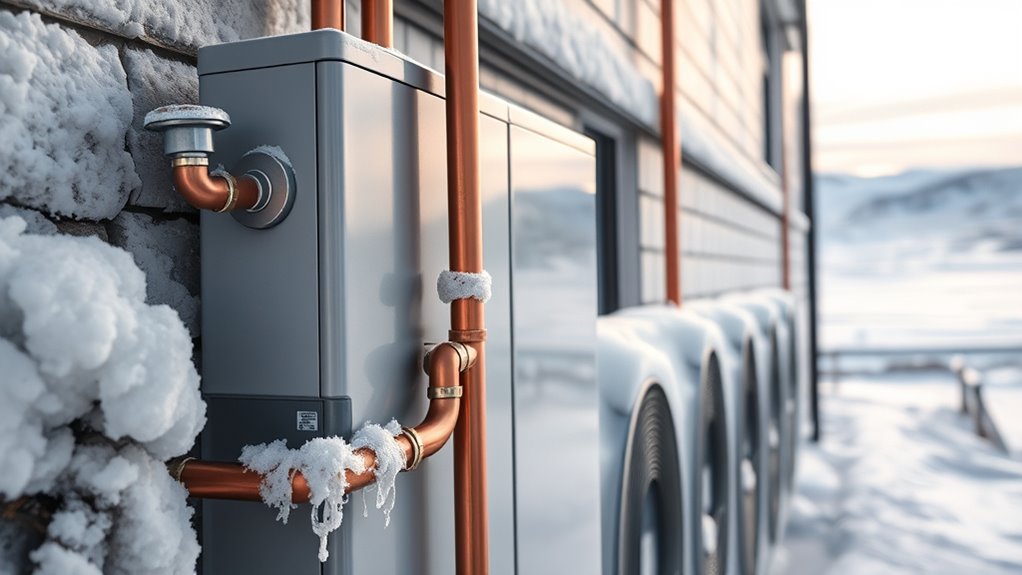
Achieving high-temperature heat pump operation above 500°C faces significant hurdles due to thermodynamic limitations and current refrigerant technologies. Developing high-temperature heat pumps that can provide sufficient thermal output for industrial processes remains challenging, as existing refrigerants struggle to operate efficiently at these extreme temperatures and often have high global warming potential. Cold climate conditions further reduce heat pump efficiency, since lower ambient temperatures decrease the coefficient of performance (COP) and limit their effectiveness in harsh winters. To advance decarbonization efforts, you need solutions that improve efficiency in cold climates and enable high-temperature operation. Innovations like new refrigerants and advanced compressor designs are essential, but they face high costs and technical complexities, slowing widespread adoption. Additionally, sound design techniques such as precise control of compressor noise and vibration can help mitigate operational issues and improve overall system reliability. Moreover, improving system efficiency is vital for making high-temperature heat pumps more viable in diverse environments. Incorporating advanced materials can further enhance system durability and thermal performance, helping overcome current technological barriers. Research into alternative refrigerants with lower global warming potential is also critical to meet environmental standards while maintaining performance.
Strategies to Overcome Barriers and Accelerate Adoption
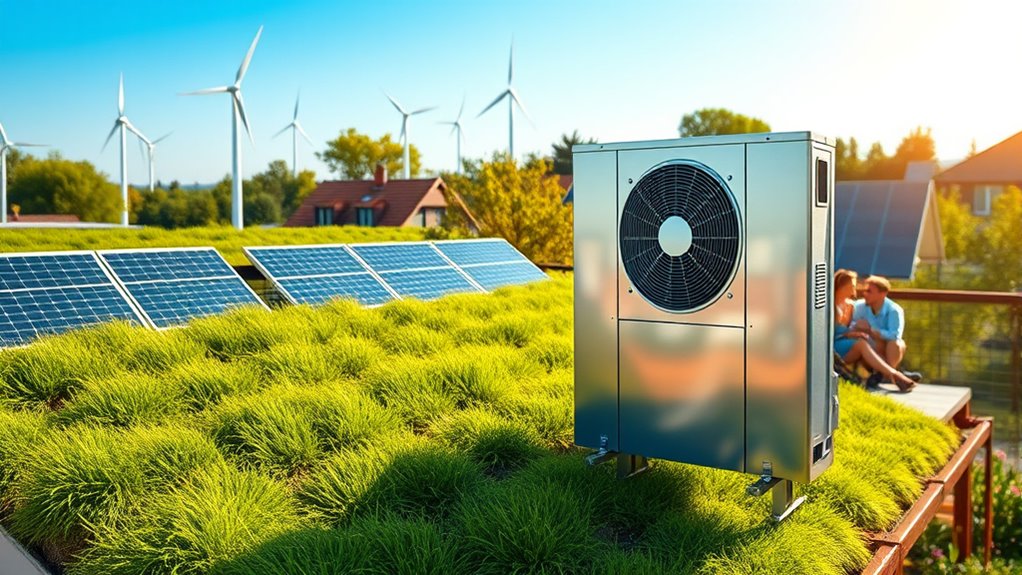
To overcome barriers and accelerate adoption of advanced heat pump technologies, targeted strategies must address both technical and economic challenges. Increasing heat pump sales depends on policy incentives like subsidies and tax credits, which lower upfront costs and encourage consumers and industries to adopt thermal solutions. Upgrading infrastructure, including grids and building insulation, improves energy use efficiency and supports large-scale deployment. Promoting integrated solutions, such as heat recovery systems and district heating, helps meet increasing heat demand in cold climates and reduces reliance on fossil fuels. Expanding workforce training and manufacturing capacity also plays a pivotal role, especially in regions like Europe and North America, to sustain market growth. Additionally, leveraging training programs and skill development ensures a competent workforce capable of installing and maintaining these systems. These combined efforts will make heat pumps more accessible and essential for transitioning to a renewable energy future.
Technological Innovations and Future Prospects for Heat Pump Efficiency
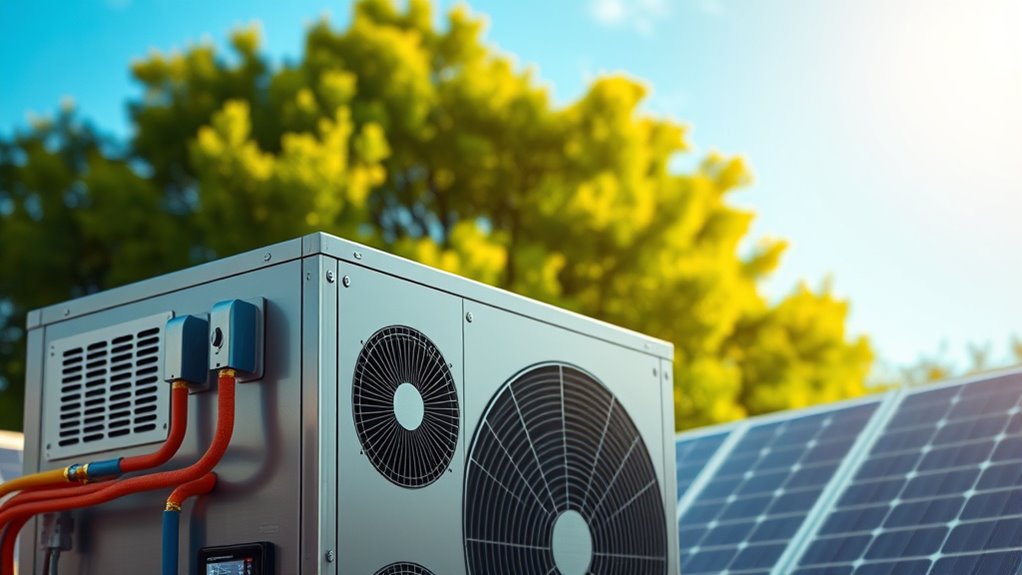
Advancements in compressor technology and refrigerant design are transforming heat pump performance, enabling units to operate efficiently at higher temperatures suitable for industrial applications. You can now imagine:
- Multi-stage systems that optimize compression stages for maximum efficiency.
- Inverter-driven units adjusting capacity dynamically to match demand.
- Refrigerant design innovations, including low-GWP options, reducing environmental impact.
- Integration of phase change materials and thermal storage for better flexibility during peak loads or variable renewable energy supply. Thermal energy management techniques are increasingly integrated to enhance overall system flexibility and efficiency.
- Mazda Tuning techniques are inspiring new approaches to optimize heat pump components for improved durability and performance under diverse operating conditions. Additionally, ongoing research into refrigerant lifecycle aims to further minimize ecological footprints.
- Innovations in compressor design are contributing to increased durability and reduced energy consumption, further boosting system performance. Furthermore, advancements in refrigerant recycling are helping to reduce waste and promote sustainability in the industry.
Policy Measures and Collaborative Efforts to Support the Transition
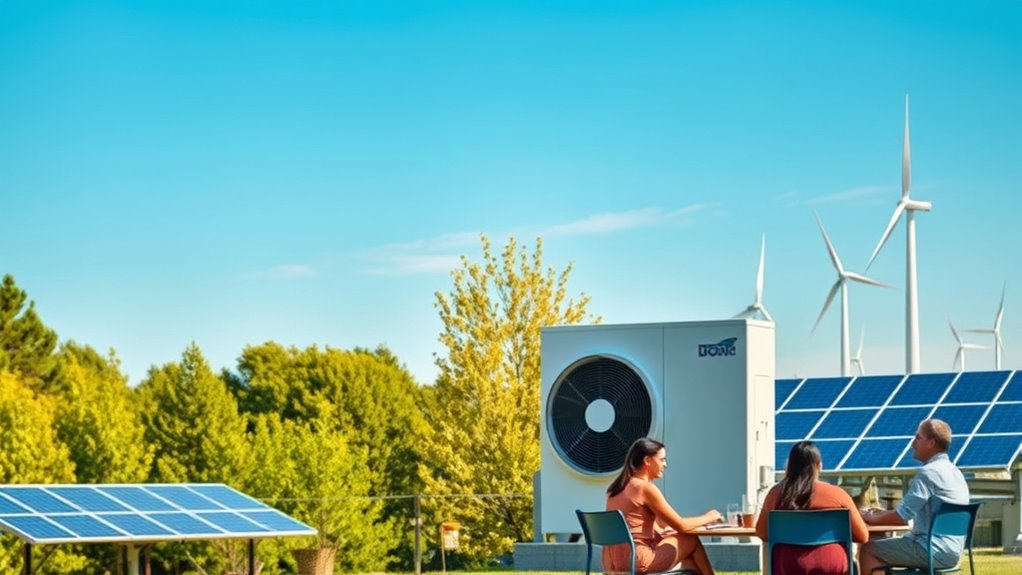
Policy incentives like subsidies, tax credits, and clear targets are key to boosting heat pump adoption. International collaboration efforts, such as those led by the IEA and EU, help share knowledge and fund large-scale renewable projects. Together, these strategies create a coordinated approach to accelerate the shift to renewable thermal energy.
Policy Incentives and Targets
Governments worldwide are actively implementing a variety of policy measures—such as subsidies, tax credits, and mandates—to boost heat pump adoption and meet ambitious renewable heating targets. These policies aim to:
- Accelerate market support by providing financial incentives that lower upfront costs.
- Set clear renewable heating targets, like Norway’s goal for all new buildings to use renewable energy by 2025.
- Integrate heat pump deployment into national climate strategies to guarantee a just transition.
- Phase out fossil fuel subsidies and introduce carbon pricing to promote cleaner options.
These government policies are essential for creating a robust policy incentives framework that drives market transformation, supports innovation, and helps achieve a sustainable, renewable heat future.
International Collaboration Strategies
International cooperation plays a vital role in expanding the adoption of heat pumps worldwide. By fostering international cooperation, countries can develop harmonized standards and certification schemes, ensuring consistent quality and safety. Policy alignment through global partnerships helps streamline regulations, making cross-border trade easier and reducing barriers. Initiatives led by organizations like IRENA and the Clean Energy Ministerial promote technology transfer and knowledge sharing, accelerating innovation and deployment. Collaborative efforts also support funding projects in developing countries, expanding access to renewable heating solutions. These multilateral dialogues enable policymakers and industry stakeholders to coordinate climate commitments, align incentives, and set international targets, such as doubling heat pump deployment by 2030. Together, these strategies create a cohesive global framework that drives the transition to renewable heating technologies.
Frequently Asked Questions
How Long Will It Take to Switch to 100% Renewable Energy?
You’re wondering how long it’ll take to switch to 100% renewable energy. Based on current trends and policies, it could take until around 2040 to 2055, depending on regional efforts and tech advancements. If you support aggressive policies and investments, the shift might speed up, possibly reaching full renewable energy within the next 25-30 years. Still, some sectors may need more time due to technical and infrastructure challenges.
Do Heat Pumps Use Renewable Energy?
You might wonder if heat pumps use renewable energy. The truth is, they can, but it depends on where your electricity comes from. If powered by renewable sources like wind or solar, then yes, heat pumps are utilizing renewable energy. As renewable energy becomes more common, heat pumps become even greener, helping you cut emissions. Just make certain your grid is decarbonized to maximize their eco-friendly benefits.
How Close Are We to 100% Renewable Energy?
You’re wondering how close we are to 100% renewable energy. Right now, only about 9% of heat comes from renewables, with most still relying on fossil fuels like coal and gas. Although renewable electricity is growing fast, it’s not enough yet to replace all non-renewable sources. To reach full renewable energy, we need massive upgrades in technology, infrastructure, and global commitment, which will take years of effort.
Are Heat Pumps Over 100% Efficient?
Imagine a magic trick where you get more out of a box than you put in. That’s how heat pumps work—their Coefficient of Performance (COP) often exceeds 4 or 5, making them over 100% efficient. You’re not converting electricity directly into heat; instead, you’re moving ambient heat, multiplying your energy. This efficiency helps reduce emissions, especially when powered by renewable energy.
Conclusion
As heat pumps become central to your shift toward 100% renewable energy, the future holds exciting breakthroughs and challenges alike. Will innovations enable their full potential in cold climates? Can policies and collaborations accelerate widespread adoption? The path ahead is filled with possibilities, and your role in supporting these advancements could be pivotal. Stay tuned—what’s next could redefine how you power your world, transforming the way we embrace a sustainable, cleaner future together.
